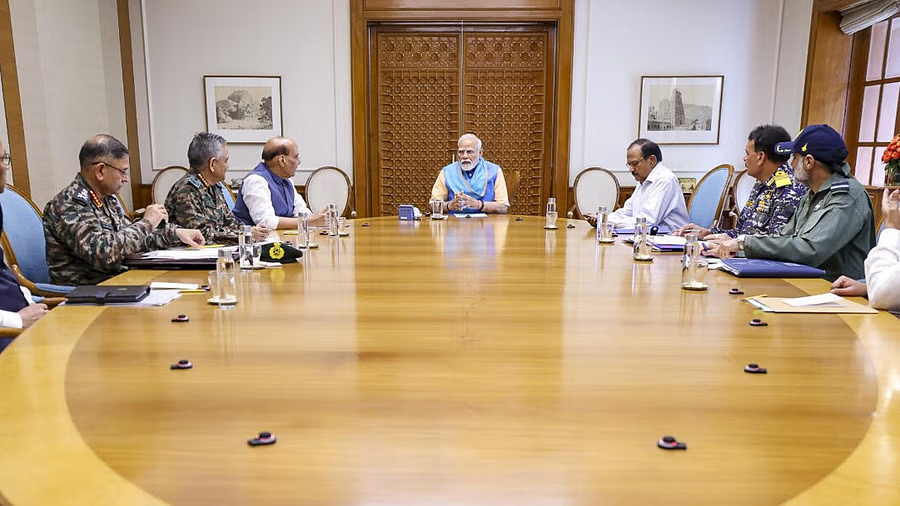In a swiftly changing scenario that has grabbed global attention, the India-Pakistan ceasefire 2025 agreement was recently reached after military actions had escalated in a tense manner. Prime Minister Narendra Modi presided over a high-level security meeting on May 12, 2025, in New Delhi, attended by top defense and intelligence officials. This blog examines the key developments, what brought about this fragile ceasefire, and the potential path forward.
Background: Growing Tensions and Operation Sindoor
The current chain of events began with a brutal terrorist attack in Pahalgam, Jammu and Kashmir, on April 22, which resulted in the deaths of 26 civilians. India responded with a strong measure. On May 7, the Indian Armed Forces launched Operation Sindoor, a wide-ranging military strike targeting terrorist training camps and infrastructure located in Pakistan and Pakistan-occupied Kashmir (PoK).
According to government sources, over 100 terrorists were neutralised in these pinpoint strikes. These camps, long believed to be backed by elements within Pakistan, have been a major concern for India for decades. Operation Sindoor sent a clear message: India would no longer tolerate state-sponsored terrorism and would act preemptively to safeguard its citizens.
Pakistan, in turn, responded with drone and missile attacks on India’s western borders, although most were intercepted by Indian air defense systems. The conflict quickly intensified to the point where it risked escalating into a full-scale war.
Ceasefire Agreement: A Respite or Just a Halt?
On May 10, the two nuclear-armed neighbors agreed to a ceasefire. The Directors General of Military Operations (DGMOs) of both countries reportedly held multiple back-channel communications to draft a mutually acceptable ceasefire framework.
The ceasefire includes:
- A cessation of military actions on land, air, and sea.
- Restoration of peace along the Line of Control (LoC).
- A temporary suspension of any cross-border operations, both official and unofficial.
- However, within 48 hours, Indian officials accused Pakistan of breaching the ceasefire, causing doubts about the agreement’s sustainability.
PM Modi’s High-Level Meeting: Main Points
To assess the security situation and plan the next steps, Prime Minister Modi chaired a high-level meeting at his residence in Delhi. The meeting included:
- Defence Minister Rajnath Singh
- External Affairs Minister S. Jaishankar
- National Security Advisor Ajit Doval
- Chief of Defence Staff General Anil Chauhan
- Army Chief General Upendra Dwivedi
- Navy Chief Admiral Dinesh K. Tripathi
- Air Force Chief Air Chief Marshal Amar Preet Singh
- Intelligence Bureau Director Tapan Deka
- RAW Chief Ravi Sinha
- Foreign Secretary Vikram Misri
- The presence of all three service chiefs and intelligence heads highlighted the gravity of the situation. According to insiders, the discussions focused on:
- Assessing ceasefire violations.
- India’s readiness in case of further escalations.
- Diplomatic outreach to key global allies.
- Cybersecurity and counter-terrorism surveillance.
The Role of Diplomacy and International Pressure Several global actors, including the United States, Russia, and the European Union, have urged restraint. Both India and Pakistan are under diplomatic pressure to avoid open conflict, especially in a region that is already unstable.
India’s foreign policy under Prime Minister Modi has consistently emphasized strategic autonomy while also fostering strong international partnerships. In the context of the India-Pakistan ceasefire 2025, External Affairs Minister S. Jaishankar’s diplomatic outreach to global counterparts could play a crucial role in sustaining ongoing peace efforts. Meanwhile, Pakistan is actively seeking support and possible mediation from allies such as China and the Organisation of Islamic Cooperation (OIC), aiming to strengthen its position on the global stage during this delicate phase.
Ground Realities in Kashmir
The people of Jammu and Kashmir continue to bear the brunt of cross-border tensions. Schools are shut, trade is halted, and daily life is marked by fear and uncertainty. The ceasefire, if truly enforced by both sides, could restore some sense of normalcy in the region.
However, locals remain sceptical. They’ve witnessed many ceasefires in the past, most of which failed due to a lack of trust and continued infiltration. This time, civil society and local leadership have urged both governments to follow through on their promises.
Strategic Implications for India
India’s response under Operation Sindoor signals a shift in military doctrine—from reactive to proactive engagement. The strikes not only disrupted terror infrastructure but also demonstrated India’s ability to conduct precision military operations without escalating to all-out war.
But a continuing state of alert also puts pressure on defence logistics, financial resources, and troop morale. Therefore, while maintaining a strong defence posture, India also needs to build diplomatic bridges to ensure long-term regional peace.
Challenges Ahead
Despite the ceasefire agreement, several difficulties remain:
Trust Deficit: Decades of conflict and betrayal make it difficult for both countries to trust each other.
Terror Infrastructure: Unless Pakistan dismantles terror camps, peace cannot be sustained.
Internal Politics: Leadership in both nations may face political criticism for showing weakness.
Public Sentiment: Nationalist sentiments are strong on both sides, making compromise difficult.
The Way Forward
Sustained Dialogue: Even casual discussions between military and diplomatic representatives can go a long way in preventing misunderstandings.
Third-Party Monitoring: An unbiased international body could be tasked with monitoring ceasefire violations.
Public Communication: Both governments need to keep their citizens informed without stirring anti-peace rhetoric.
Cross-Border Confidence Building: Reviving people-to-people contacts, trade, and cultural exchange can slowly build trust.
Conclusion
The India-Pakistan ceasefire 2025 is a welcome step, but only a small one in a long and challenging journey toward peace. It offers a window of opportunity for both countries to reassess their priorities—away from conflict and towards development, diplomacy, and dialogue. But whether this truce becomes a turning point or just another missed opportunity depends on the political will and strategic maturity of both nations.
Let us hope that this moment is not just another pause between bouts of violence but a step towards enduring peace in South Asia.
